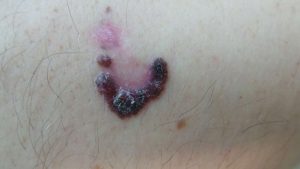What is Melanoma
- Melanoma is a cancer that develops in the multipotent pigment cells of our skin, called melanocytes.
- Patients themselves are the first to detect many melanomas.
- Caught early, most can be cured with relatively minor surgeries.
- Melanoma is the most serious and aggressive form of skin cancer because it may spread (metastasise) to other parts of the body and cause serious illness and death.
- Moles suspected as melanoma usually show one or more of the following changes and/or signs (ABCDΕ):
- Α – Asymmetry
- Β – Border
- C – Colour, changes in terms of colour or too many colours in a spot or mole
- D – Diameter larger than 6mm (the size of a pencil eraser)
- E – Evolving, i.e. morphological changes in a short time period
- Elevated risk factors for melanoma include fair skin, light hair and light-coloured eyes, a history of intense sun exposure, close blood relatives with melanoma, and moles that are unusually numerous, large, irregular, or “funny looking”.
- To diagnose melanoma, a biopsy is required, during which a piece of skin is removed for histopathological analysis. Whenever possible, the removal of the whole lesion is preferred.
- The most common forms of melanoma are superficial spreading melanoma, nodular melanoma and lentigo maligna melanoma .
- The main treatment of melanoma is early surgical removal.
- Changing moles or suspicious skin spots should be brought to the dermatologist’s attention right away.
- Mole mapping with specialised equipment and dermoscopy are the best preventive measures for melanoma.
Who is at increased risk of developing melanoma?
Most people who suffer from melanoma have pale skin; however, this does not mean that people with brown and black skin are excluded. Some people have higher risk of developing melanoma. They have the following characteristics:
Skin
- Pale skin, the risk is greater if a person has red or blonde hair and blue or green eyes.
- Skin sensitive to the sun, that rarely tans or burns easily (Fitzpatrick Skin Type 1 – Phototype).
- More than 50 moles with irregular appearance (dysplastic nevi syndrome).
- People who had serious sunburns or after prolonged sun exposure or sun bed use have greater risk of developing melanoma.
Family / Medical History
- If there is a family history, the chances of getting a melanoma increase.
- History of skin cancer or another melanoma in the same patient increases the chance of developing melanoma.
- Weakened immune system.
What causes melanoma?
Ultraviolet radiation (UV) contributes significantly in most cases. Sources of ultraviolet radiation include the sun and sunbeds. Heredity plays a role, too. Research studies have demonstrated that if a close blood relative (parent, child, sibling, aunt, uncle) had melanoma, a person is at much higher risk of developing melanoma.
What are the types of melanoma?
The main types of melanoma are:
- Superficial spreading melanoma: This is by far the most common type, accounting for about 70% of all cases of melanoma. The most common areas are the legs in women and the upper back in men, while it usually appears between the ages of 30-50 years. If left untreated, it develops into nodular melanoma.
- Nodular melanoma: Approximately 20% of melanomas begin as blue-black violet nodules. They progress quickly and they may spread before diagnosis.
- Lentigo Maligna Melanoma: Unlike other forms of melanoma, it tends to appear in areas of the body, such as the face, which are constantly exposed to the sun. Malignant lentigos look like large freckles with irregular size or coloured, and they develop slowly.
- Moreover, there are other less common types of melanoma, such as melanoma below the nails (subungual melanoma), melanoma on the palms and soles, choroidal melanoma (ocular melanoma), melanoma in the oral or vulvar mucosa or even melanoma inside the body.
What is the treatment for melanoma?
In general, melanoma can only be treated with early surgery. Then the sentinel lymph node is examined, and staging is performed. During the treatment of many, early diagnosed melanomas, surgeons remove just 1 cm of the normal tissue surrounding the melanoma. In deeper and more advanced cancers, more extended surgery may be required.
In all cases of melanoma, the results of the biopsy are of utmost importance for choosing the appropriate treatment.
Depending on various factors (tumour thickness, body location, age, etc.), the removal of nearby lymph nodes may be recommended.
For advanced disease, such as when the melanoma has spread to other parts of the body, chemotherapy may be sometimes recommended. Patients with melanoma are more likely to develop a 2nd melanoma. Dermatological examination at regular time intervals for life is essential.



